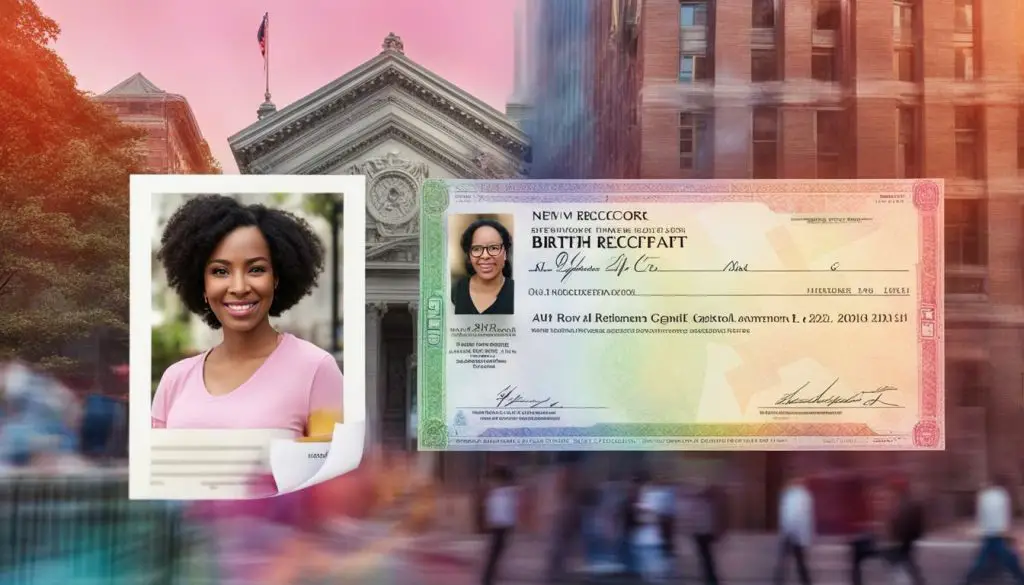Legal gender recognition is an essential aspect of affirming transgender individuals’ identity, and the ability to change their birth certificates plays a crucial role in this process. Birth certificates serve as essential documents that reflect a person’s identity and are often required for a variety of legal and administrative purposes. However, for transgender individuals, birth certificates may not accurately reflect their gender identity, leading to discrimination and a lack of legal recognition.
In some states, like New York, transgender individuals have the opportunity to change the sex designation on their birth certificates. This process typically involves submitting an application and a notarized affidavit from a licensed healthcare provider. Notably, New York City also allows for a gender marker change on birth certificates, provided individuals have appropriate documentation from a healthcare provider or another licensed professional.
However, it is important to note that the process of changing one’s name and gender marker on birth certificates can vary by state. Some states may not allow for changes to be made on birth certificates, making the process more complex for transgender individuals seeking legal recognition. In such cases, obtaining a court-ordered gender change can help establish the legal recognition of a gender transition. This may involve completing court forms, obtaining a declaration from a healthcare provider, filing the forms at a courthouse, and attending a court hearing.
Additionally, transgender individuals may also consider changing their gender markers on identification documents, such as a California state ID or driver’s license. In California, this can be done by submitting the appropriate form along with confirmation from a licensed physician or psychologist.
While the process of changing one’s legal name and gender marker may seem daunting, it is important to remember the potential benefits. Changing one’s name and gender marker can contribute to increased safety, improved mental health, and a sense of affirmation. It allows transgender individuals to live authentically and align their legal documentation with their gender identity.
However, navigating the legal process can be challenging for transgender individuals. Potential barriers and discrimination may arise, highlighting the need for resources and support. Organizations like the National Center for Transgender Equality can provide guidance and assistance throughout the process.
In conclusion, legal gender recognition is vital for affirming transgender individuals’ identities. The ability to change birth certificates and other identification documents not only provides legal recognition but also promotes inclusivity and equality. It is crucial to continue advocating for transgender rights and ensuring that individuals have access to the necessary resources to navigate the legal process successfully.
In New York, transgender individuals have the opportunity to change the sex designation on their birth certificates, provided they meet certain requirements. To begin the process, individuals must submit an application and a notarized affidavit from a licensed healthcare provider. This documentation serves as evidence of the individual’s gender identity and their need for a gender marker change.
New York City takes an additional step in the process, allowing for a gender marker change on birth certificates with documentation from a healthcare provider or another licensed professional. This expanded approach recognizes the importance of accessibility and supports transgender individuals in obtaining legal recognition of their gender identity.
It is important to note that the process of changing one’s name and gender marker can vary from state to state. Some states may not permit changes to be made on birth certificates, necessitating the pursuit of a court-ordered gender change. This involves completing court forms, obtaining a declaration from a healthcare provider, filing the forms at a courthouse, and attending a court hearing.
Changing the gender marker on identification documents, such as a California state ID or driver’s license, follows a similar process. Individuals can submit the appropriate form along with confirmation from a licensed physician or psychologist to update their gender marker. It is crucial to be aware of the specific requirements and procedures for each state to ensure a smooth and successful transition.

While there may be costs associated with changing one’s legal name and gender marker, financial assistance options are available to those in need. It is important to consider the potential benefits of making these changes, which include increased safety, improved mental health, and a sense of affirmation. However, it is also vital to acknowledge that the process can present challenges, such as navigating the legal system and potential discrimination.
Fortunately, there are resources available to support transgender individuals throughout the process. The National Center for Transgender Equality, for example, offers guidance, information, and advocacy for those seeking to change their name and gender marker. By utilizing these resources and seeking support from the community, individuals can navigate the challenges and work towards achieving legal recognition of their gender identity.
Exploring State Variations on Gender Marker Changes
While New York grants transgender individuals the ability to change their gender markers on birth certificates, it’s important to note that the process can differ significantly from state to state. Each state has its own regulations and requirements for legal gender change on birth certificates, making it essential for transgender individuals to familiarize themselves with their state’s specific laws.
Some states may not allow for changes to be made on birth certificates at all, which can create additional challenges for transgender individuals seeking legal recognition of their gender identity. In these cases, obtaining a court-ordered gender change may be necessary. This involves completing court forms, obtaining a declaration from a healthcare provider, filing the forms at a courthouse, and attending a court hearing.
To illustrate the variations in state laws, let’s take a look at California. In California, transgender individuals can change their gender marker on a state ID or driver’s license by submitting the appropriate form along with confirmation from a licensed physician or psychologist. This process differs from changing the gender marker on a birth certificate and highlights the need to understand the specific requirements in each state.
| State | Birth Certificate | ID/Driver’s License |
|---|---|---|
| New York | Application and notarized affidavit from a licensed healthcare provider | Documentation from healthcare provider or licensed professional |
| California | Varies by county | Appropriate form and confirmation from a licensed physician or psychologist |
| Other states | May require court order | Varies by state |
It is important for transgender individuals to consult legal professionals or organizations specializing in transgender rights to navigate the complexities of changing their name and gender marker. These resources can provide guidance on the specific laws in each state and offer support throughout the process. The National Center for Transgender Equality, for example, is dedicated to advancing transgender equality and provides valuable information and resources to assist individuals in their journey towards legal recognition.

By understanding the variations in state laws and accessing the necessary resources and support, transgender individuals can navigate the challenges of changing their name and gender marker with confidence and work towards achieving legal recognition of their gender identity.
Changing Gender Markers on Identification Documents
California provides transgender individuals with an opportunity to change their gender markers on identification documents, such as state IDs and driver’s licenses, by following a specific process. This process allows individuals to align their identity with their legal documentation, providing a sense of affirmation and recognition.
The first step in changing the gender marker on a California state ID or driver’s license is to fill out the appropriate form. This form, available online or at a local DMV office, requires individuals to provide personal information and indicate the desired gender marker change.

Once the form is completed, it must be submitted along with supporting documentation. This typically includes a notarized letter or confirmation from a licensed physician or psychologist, verifying the individual’s gender identity. It is important to note that the specific requirements may vary, so it is advisable to consult the California DMV website or contact the local DMV office for accurate and up-to-date information.
Upon submission of the form and supporting documentation, the California DMV will review the application and, if approved, issue a new identification document reflecting the gender marker change. It is important to keep in mind that there may be fees associated with this process, so it is advisable to check the DMV website or contact the local DMV office for information regarding any applicable fees.
Cost and Benefits of Changing Legal Name and Gender Marker
Changing one’s legal name and gender marker can have a significant impact on transgender individuals’ lives, providing numerous benefits and opportunities for increased well-being. It is a crucial step towards aligning one’s identity with their legal documentation, allowing for a more authentic and affirming representation.

One of the primary benefits of changing one’s legal name and gender marker is the increased safety and security it affords. By having identification documents that accurately reflect their gender identity, transgender individuals can avoid potential conflicts, discrimination, and harassment when presenting their identification in various settings.
Improved mental health is another significant advantage of changing one’s name and gender marker. Research has shown that aligning one’s legal documentation with their gender identity can lead to reduced anxiety and depression, as well as increased self-esteem and overall well-being. It allows individuals to live authentically and be recognized by their chosen name and gender in all aspects of their lives.
Furthermore, changing one’s name and gender marker can provide a sense of affirmation and validation. It allows transgender individuals to have their true identity recognized by society, fostering a greater sense of belonging and acceptance. This recognition can positively impact relationships, social interactions, and overall quality of life.
While the process of changing legal name and gender marker may vary by state, financial assistance may be available to those who need it. It is essential for transgender individuals to explore all available resources, including non-profit organizations and legal aid services, to ensure a smooth and affordable transition process.
| Benefits | Financial Assistance |
|---|---|
| Increased safety and security | Non-profit organizations |
| Improved mental health | Legal aid services |
| Sense of affirmation and validation |
Navigating Challenges in the Legal Process
While the process of changing one’s name and gender marker is essential for transgender individuals, it can present challenges, including legal complexities and potential discrimination. Navigating the legal process can be overwhelming, but there are resources available to help transgender individuals overcome these obstacles.
One challenge that transgender individuals may face is the varying requirements and procedures for changing gender markers on birth certificates. Each state in the United States has its own laws and regulations regarding legal gender recognition. Some states may not allow for changes to be made on birth certificates, requiring individuals to pursue a court-ordered gender change for legal recognition.
Discrimination is another challenge that transgender individuals may encounter when navigating the legal process. Despite advancements in transgender rights, many transgender individuals still face discrimination and bias in various aspects of their lives, including access to legal recognition of their gender identity. Discrimination can manifest in denial of services, mistreatment, and unfair treatment in court proceedings.

However, there are organizations and resources available to support transgender individuals through the legal process. The National Center for Transgender Equality offers guidance, education, and advocacy on transgender rights, including assistance with legal name and gender marker changes. They provide resources such as sample court forms, information on state-specific laws, and referrals to legal service providers who specialize in transgender legal issues.
It is important for transgender individuals to be aware of their rights and seek out support when navigating the legal process of changing their name and gender marker. While the journey may be challenging, it is a significant step towards affirming one’s identity and obtaining the legal recognition that is crucial for their well-being and inclusion in society.
Conclusion
In conclusion, transgender individuals can change their birth certificates through a complex legal process, allowing for the affirmation of their gender identity and providing documentation that reflects their true selves. In New York, individuals can submit an application and a notarized affidavit from a licensed healthcare provider to change the sex designation on their birth certificates. New York City also permits a gender marker change on birth certificates with documentation from a healthcare provider or another licensed professional.
However, the process of changing one’s name and gender marker varies by state, and some states may not allow for changes to be made on birth certificates. In such cases, obtaining a court-ordered gender change can help establish the legal recognition of a gender transition. This may involve completing court forms, obtaining a declaration from a healthcare provider, filing the forms at a courthouse, and attending a court hearing.
It is also possible to change the gender marker on a California state ID or driver’s license by submitting the appropriate form, along with confirmation from a licensed physician or psychologist. The cost of changing one’s legal name and gender marker varies by state, and individuals may be able to access financial assistance to help with these expenses.
While the process of changing legal documentation can be challenging, it is important to recognize the benefits that come with it. Changing one’s name and gender marker can provide increased safety, improved mental health, and a greater sense of affirmation. However, it is crucial to acknowledge that transgender individuals may face discrimination and other obstacles throughout the legal process. Resources such as the National Center for Transgender Equality are available to provide support and guidance in navigating these challenges and advocating for transgender rights.
FAQ
Can transgender individuals change the sex designation on their birth certificates?
Yes, in New York, transgender individuals can change the sex designation on their birth certificates by submitting an application and a notarized affidavit from a licensed healthcare provider. New York City also allows for a gender marker change on birth certificates with documentation from a healthcare provider or another licensed professional.
Does the process of changing one’s name and gender marker vary by state?
Yes, the process of changing one’s name and gender marker varies by state. Some states may not allow changes to be made on birth certificates. However, obtaining a court-ordered gender change can help establish the legal recognition of a gender transition. The process may involve completing court forms, obtaining a declaration from a healthcare provider, filing the forms at a courthouse, and attending a court hearing.
How can one change the gender marker on a California state ID or driver’s license?
To change the gender marker on a California state ID or driver’s license, individuals can submit the appropriate form along with confirmation from a licensed physician or psychologist.
What is the cost of changing one’s legal name and gender marker?
The cost of changing one’s legal name and gender marker varies by state. Financial assistance may be available to those who need it.
What are the benefits of changing one’s legal name and gender marker?
Changing one’s legal name and gender marker can have numerous benefits, including increased safety, improved mental health, and a sense of affirmation.
What challenges may transgender individuals face when changing their name and gender marker?
Transgender individuals may face challenges such as navigating the legal process and potential discrimination. However, resources are available, such as those offered by the National Center for Transgender Equality, to assist with the process of changing one’s name and gender marker.
Source Links
- https://legacy.lambdalegal.org/know-your-rights/article/trans-changing-birth-certificate-sex-designations
- https://getplume.co/blog/unlocking-the-possibilities-of-trans-names-exploring-the-benefits-and-challenges-of-changing-your-name/
- https://transgenderlawcenter.org/resources/id/faq-the-vital-statistics-modernization-act/